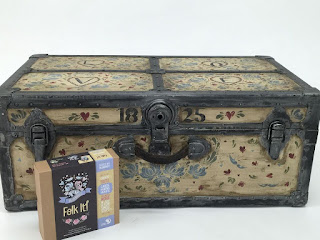You may have seen the canal boats of England, the romantic, shabby chic style of Tole painting and the beautiful swirling brushstrokes of Norweigan Rosemaling. Although it may take many forms around the world, adopting its own style and colour schemes, we use the term Folk Art to describe art created for decorative purposes. More specifically, Folk Art painting as it commonly became known in the 1700’s, was developed by ordinary people for ordinary people.
Years ago, art was seen as the privilege of the rich and only those who could afford art training were allowed to access the knowledge and skills of painting, drawing and sculpture. It was these skilled artists and painters that were commissioned to decorate the furniture and homes of the wealthy. Decorated wedding chests, beautifully painted walls and decorated furniture all became symbols of wealth and success and it wasn’t long before peasants wished they could do the same and as a result, they created a beautiful style all of their own. Often known as naive art, this Folk Art painting lacks perspective, shading, dimension and proportion. In short, it ignores the rules often found in traditional art forms.
 |
| Painted chest from the Hungarian Applied Folk Art Museum |
The Folk Art that we know and love at You Can Folk It! is made up of a limited number of brushstrokes that combine in a multitude of ways to create a variety of designs and beautiful patterns. It is quite simply, a skill-based art: this means that with practice, anyone can learn to move the brush to create the brushstrokes they want to. When we learn to write, we learn the alphabet and then move on to learning how to combine the letters into words. The same principle applies to Folk Art - the painter learns the brushstrokes and once they feel confident creating those, the learn how to combine them to create different patterns and flowers.
Folk Art was never about trying to create perfect pieces of art, it was created to allow ordinary people to express themselves and to help them put their creative stamp on the world. It was never interested in following rules but encouraged people to paint in a way that they never thought they could before. For these reasons, it became a pastime that families enjoyed together with older generations passing on the skills they had learnt to younger members of the family.
With this teaching, it became very popular and began to spread around the world with different countries developing its own style from the bright and bold canal art of England to the sweeping beauty of Bauernmaleri.
 |
| Folk Art can be used to decorate a number of household items - it became a way for people to create a home they were proud of and give meaningful gifts. |
However, as the years passed and technology developed, these skills were not passed on as they once were and it wasn’t until the 60’s and 70’s that Folk Art stepped into the spotlight once again. Known as the pioneers of this revival, Jo Sonja Jansen, Priscilla Hauser and others rediscovered the art of their ancestors and with a desire to recreate family heirlooms, they began learning the skills of their ancestors influenced by Norwegian and Pennsylvanian Dutch Folk Art.
Their actions created a buzz in their communities and soon, Folk Art began to spread again becoming popular in America and Australia. It was during this revival in the 90's that Carol, the Founder of You Can Folk It discovered Folk Art for herself. Wanting to carve out a bit of time for herself after her boys started school, she wanted to do something creative but didn’t feel artistic. When she tried to complete traditional art classes, she didn’t ‘click’ with the rules of shading and perspective. However, after walking through the door to her first Folk Art workshop she felt excited by the potential. Finally, she felt confident that she’d found something achievable and something loved to do.
 |
| Just one of the kits from You Can Folk It - this one teaches you how to paint Hindeloopen style flowers and birds |
Fast forward 20 years and Carol has taught this beautiful art form around the world. After learning a wide range of Folk Art and teaching many different classes, she has experienced the physical and emotional benefits of Folk Art for herself and those experienced by her students. Just as the original creators of Folk Art, she passionately believes that anyone can learn to paint, whether they are artistic or not. Wanting to reach more people, she has packaged her knowledge into a series of lessons which can be enjoyed in the comfort of your own home (they can also now be enjoyed in a workshop with one of our Ambassadors) with the aim of bringing the wonder Folk It to you. This comprehensive education system means that anyone can learn to paint.
For a skill that has been around for hundreds of years, its popularity may have waned throughout certain eras but it shows no signs of disappearing. We only hope that it continues to spread around the world and once again gets passed down the generations to be enjoyed by all. If you would like to share your story of how Folk Art has helped you, we'd love to hear from you.
Happy Folking!

Thanks for sharing about Traditional Painting. Your content is realy informative for us......
ReplyDeleteIndian Traditional Paintings
Indian Painting
Traditional Paintings
Traditional Painting
Indian Traditional Painting
Traditional Paintings
Traditional Painting